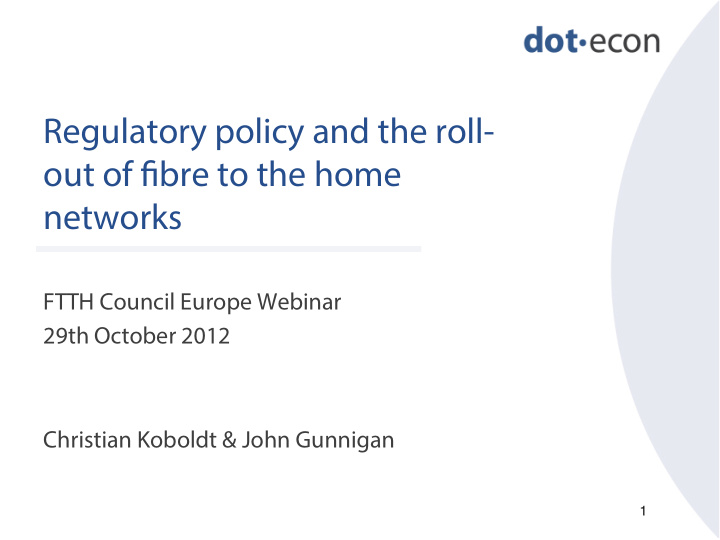



Regulatory policy and the roll- out of fj bre to the home networks FTTH Council Europe Webinar 29th October 2012 Christian Koboldt & John Gunnigan 1
The case for fj bre to the home Low latency High bandwith Consistent (both down- quality and upload) New services Consumer surplus Social bene fj ts 2
The DA ultrafast broadband target is a long way from being met, and fj bre is not much used … Few fj xed broadband connections in Europe o ff ering 100Mbps and above DA scoreboard June 2012 100 Mbps and above, 30 Mbps and above 1.3% and below 100 Mbps, 7.2% Little progress so far Source: DA scoreboard 2012 FTTH/FTTB in Europe behind other regions in the world Above 144 Kbps and below 30 Mbps, 91.5% % of households/ 100 population 90 80 70 60 50 40 30 20 10 0 DSL (2009) Cable (2008) FTTH/FTTB (2009) 3 EU average USA Korea Japan Australia OECD average Source: OECD Source: DA scoreboard 2012
Strong public policy case – challenging business case Services need infrastructure – Future demand is uncertain infrastructure needs services Future Costs are regulatory substantial and “Wait and environment is largely sunk uncertain see” is quite attractive 4
It’s not just about the prospect of regulation Obligation to provide • Potentially very large returns in success case required to compensate for risk cost-based access • Regulatory commitment may be in doubt matters, but promising • Higher allowable charges for fj bre access may to allow high returns is not be relevant if fj bre premium is limited unlikely to be su ffi cient • Higher fj bre access charges makes fj bre Copper and fj bre investment attractive for incumbents but competing not just for entrants are likely to favour cheaper access to existing copper services investment, but also • Lower retail prices for copper-based access end-user demand products limit return on fj bre 5
Low prices drive fj bre take-up FTTH penetration in 16% 2011 SE 14% SK 12% SI BG 10% LT 8% DK EE PT 6% NL 4% FI FR 2% BE IT ES AT DE 0% 40% 60% 80% 100% 120% 140% 160% 180% Fibre retail price/copper retail price in 2011 Source: Heavy Reading (FTTH in Europe: Forecast & Prognosis, 2011-2016) and Van Dijk (Comparison of Broadband Internet Access Cost 2011) 6
Examples of pro- fj bre policy across Europe Risk premia in Leverage on power Service trials in Nuenen, calculation of fj bre companies’ subsidised by the access charges obligation to roll out government, raise the smart grids to lay fj bre premium down fj bre at the same time Municipality co- operation to exploit economies of scale IRU access of fj bre and knowledge network built by sharing to lower roll- France Télécom, SFR, out cost by taking Free Infrastructure advantage of and Bouyges. planned works on the sewage system in the area to install ducts MoU between government and De-regulating operators to build wholesale shared-passive access in infrastructure for the competitive development of areas NGNs. 7
Conducive regulatory framework for fj bre investment required Target reasons for a potentially arti fj cially distorted fj bre premium • Better information about service quality Regulatory options should focus on accommodating challenges in fj bre business case • Di ff erentiated access prices (but discrimination concerns?) • Co-investment from service providers (but net neutrality issues?) Greater certainty and clarity over the speci fj c regulation of fj bre networks in the future is required • Implementation of NGA recommendation across Member States still in its infancy – and what it means in practice rather unclear 8
Promoting fj bre investment during the transition phase Measures to prevent • ‘Tax’ on copper access to drive a access price wedge between copper wholesale di ff erentials feeding and retail prices • Allow incumbents to withdraw through to retail copper-based access products as prices may be soon as fj bre alternative is available required • By averaging access charges across the two networks? Allow higher access • By making these higher charges charges on both fj bre conditional on fj bre investment? and copper networks 9
Public policy case may be stronger than even the strongest business case … Social bene fj ts not fully re fm ected in business case because of positive externalities (growth, employment, social inclusion etc.) Charging regulators Direct public sector more explicitly with involvement in Full government promoting pushing the roll-out funding and owning investments (e.g. of fj bre access Adopting a ‘ fj bre of a network, for through allowing or networks (e.g. switchover’ policy. instance in Australia; disallowing certain through soft funding or even investments, as in or public-private airport regulation) partnerships) 10
Recommend
More recommend